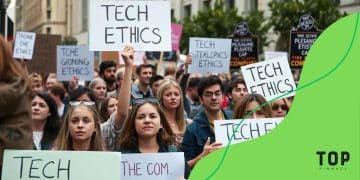Climate crisis media focus: why it matters now

The climate crisis media focus significantly influences public awareness and policy-making by utilizing innovative storytelling, effective data visualization, and diverse perspectives to inspire action against climate change.
The climate crisis media focus highlights urgent issues that affect us all. Ever wondered how media shapes our understanding of the climate challenges we face? Let’s dive into its significance.
The current state of the climate crisis
The current state of the climate crisis is alarming. Rising temperatures and extreme weather events are more frequent than ever. Scientists warn that we must act swiftly to mitigate its effects on our planet.
One major issue is the increase in carbon emissions. These emissions are a direct result of human activity, including burning fossil fuels, deforestation, and industrial processes. As greenhouse gases accumulate, the planet warms, leading to significant changes in our environment.
Impact of Climate Change
Climate change affects ecosystems around the globe. Wildlife is losing habitats, and many species are facing extinction. We also see significant changes in weather patterns.
- Increased frequency of hurricanes
- Longer droughts affecting agriculture
- Melting ice caps and rising sea levels
Moreover, vulnerable communities often bear the brunt of these changes. People in low-lying areas are at risk of displacement due to rising seas. Access to clean water becomes compromised, affecting health and livelihoods.
Recent Studies
Recent studies show that global temperatures have risen by approximately 1.2 degrees Celsius since pre-industrial times. This increase is primarily due to human activities.
- More than 90% of the earth’s warming is absorbed by the oceans.
- Heatwaves are becoming more intense, resulting in higher mortality rates.
- Extreme weather is damaging infrastructure and disrupting economies.
As the climate crisis worsens, urgent action is required. Countries are encouraged to implement sustainable practices and reduce their carbon footprint. Transitioning to renewable energy sources can make a significant difference.
Media’s role in shaping public perception
The media plays a critical role in shaping public perception of the climate crisis. It informs, influences, and engages audiences about the implications of climate change. By highlighting relevant events and scientific findings, the media can draw attention to the urgency of climate issues.
Through various platforms like television, social media, and online news, information about the environment is disseminated widely. This coverage often shapes how people understand the causes and consequences of climate change. By presenting facts and personal stories, the media fosters a connection between global issues and local communities.
Types of Media Coverage
Different types of media coverage impact public perception in unique ways. News reports often present raw data and statistics, while documentaries provide in-depth explorations of specific issues. Both formats have their advantages.
- News articles highlight recent events and policies.
- Documentaries inform and educate with visual storytelling.
- Social media encourages user engagement and discussion.
As the conversation around the climate crisis grows, popular culture also contributes. Movies, podcasts, and literature can bring awareness and provoke thought regarding environmental issues. These narratives can inspire action and motivate change.
Challenges in Media Reporting
However, there are challenges in how the media presents these stories. Often, sensationalism can lead to misinformation. Simplistic portrayals can detract from the complexity of the climate crisis. Instead, facts should be communicated with clarity and accuracy to foster informed discussions.
- Over-dramatization can lead to public apathy.
- Misrepresentation of scientific data undermines credibility.
- Balanced reporting is essential for effective communication.
In a world overwhelmed by content, the media’s responsibility is ever greater. By being strategic in their storytelling, journalists can properly inform the public and inspire action toward combating the climate crisis.
Impact of climate crisis coverage on policy

The impact of climate crisis coverage on policy is significant and far-reaching. Media stories can drive public awareness and influence government action. When the media highlights urgent climate issues, policymakers feel the pressure to respond and create effective solutions.
News reports, documentaries, and social media discussions shape public opinion, leading to greater demand for action. As communities become more informed, they often push their leaders to take climate change seriously.
Key Influences on Policy Making
Various aspects of media coverage can influence policy decisions. For instance, when major events occur, the media often covers them extensively, raising public concern. Increased media attention can lead to:
- More government funding for climate initiatives
- Stricter regulations on emissions and pollution
- Development of sustainable energy policies
Moreover, the framing of climate issues in the news affects how people understand and respond to them. Journalism that emphasizes the urgency and severity of the climate crisis can motivate quicker action from legislators. Conversely, downplayed or misrepresented issues can slow progress.
Case Studies of Media Influence
Several case studies illustrate how strong media coverage sparked policy changes. For example, after major climate-related disasters, such as hurricanes or wildfires, extensive media reporting often leads to public outcry. As a result, policymakers may prioritize climate resilience measures and disaster preparedness.
- Increased funding for renewable energy projects post-disaster.
- Public campaigns for better infrastructure to handle climate impacts.
- Global discussions at events like COP conferences influenced by media narratives.
Overall, the connection between media and policy is essential in tackling the climate crisis. Effective coverage not only informs the public but also compels action at all levels of government.
Case studies of effective climate communication
Case studies of effective climate communication provide valuable insights into how information can influence public opinion and drive action. These examples show the power of storytelling and strategic messaging in conveying the urgency of the climate crisis.
One notable case is the “This is Your Air” campaign, which highlights air pollution’s impact on daily life. By using relatable visuals and personal stories, it connects the audience to health issues, encouraging them to advocate for cleaner air. This campaign successfully raised awareness and prompted local governments to take action.
Successful Documentaries
Documentaries are another effective tool for climate communication. Films like “Our Planet” showcase stunning visuals of nature while addressing environmental issues. Such documentaries inspire viewers to engage in climate activism. They often spark discussions in social circles, encouraging collective environmental responsibility.
- Engaging storytelling elicits emotional responses.
- Visually striking content captures attention.
- Accessible platforms make information widely available.
Another excellent example is the “Seas of Change” initiative, which used community-based workshops to educate local fishermen about sustainable practices. By involving communities in the conversation, this approach fostered a sense of ownership and responsibility towards their environment.
Social Media Impact
The rise of social media has also transformed climate communication. Platforms like Twitter and Instagram allow rapid information sharing. Activists leverage these tools to mobilize support and raise awareness. Campaigns like #FridaysForFuture have shown how social media can unite people globally to demand action.
- Hashtags increase visibility and engagement.
- Influencer partnerships broaden reach.
- Real-time updates maintain engagement.
Overall, examining these case studies reveals that effective climate communication combines emotion, storytelling, and community involvement to drive change. Engaging narratives and visuals can motivate audiences to take action, making a real impact in the fight against the climate crisis.
Future trends in climate crisis reporting
Future trends in climate crisis reporting indicate a shift toward more interactive and engaging formats. As technology evolves, journalists and media outlets are finding innovative ways to present information. This will help audiences connect with climate issues more deeply.
One trend is the use of immersive storytelling techniques. Virtual reality (VR) and augmented reality (AR) enable audiences to experience the effects of climate change firsthand. For example, viewers might explore virtual scenarios of rising sea levels in their own communities. Such experiences can create a sense of urgency and empathy.
Data Journalism and Visualization
Data journalism is playing a significant role in climate reporting. Journalists are using data to tell compelling stories about climate trends. By presenting statistics and forecasts visually, readers can better understand complex issues. This approach often includes:
- Interactive graphs that show temperature changes over time.
- Maps highlighting climate hotspots around the world.
- Infographics summarizing key data points.
These visual elements not only enhance understanding but also encourage sharing on social media platforms, bringing climate issues to a broader audience.
Collaboration Across Mediums
Moreover, collaboration between different media formats is increasing. Podcasts and videos are being integrated into traditional articles to offer varied content experiences. Combining audio, visual, and text elements caters to diverse audience preferences. This multisensory approach allows deeper engagement and understanding of the climate crisis.
As climate change becomes a more pressing issue, there is a shift toward solution-oriented journalism. Reporters are increasingly focusing on successful initiatives and positive actions being taken in different communities. Empowering stories show that change is possible, inspiring hope and motivating solutions.
Global Perspectives
Finally, future trends in climate crisis reporting will likely emphasize global perspectives. Broadening the range of voices and experiences represented in climate narratives will lead to more inclusive discussions. Stories from developing nations and marginalized communities can illustrate the global interconnectivity of climate issues.
By exploring these diverse perspectives, journalists can foster solidarity in the fight against the climate crisis, uniting people under a shared cause.
FAQ – Frequently Asked Questions about Climate Crisis Reporting
What is the role of media in climate communication?
The media informs the public about the climate crisis, influencing opinions and prompting action from policymakers and individuals.
How does data journalism improve climate reporting?
Data journalism uses statistics and visualizations to make complex climate information more understandable and engaging for the audience.
What are some effective ways to communicate climate issues?
Effective communication includes storytelling, immersive experiences like VR, and solution-oriented narratives that showcase positive actions.
Why is it important to include diverse perspectives in climate reporting?
Including diverse voices helps to highlight the global impacts of climate change and fosters solidarity among different communities affected by the crisis.






